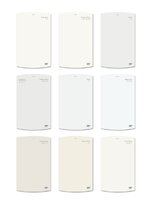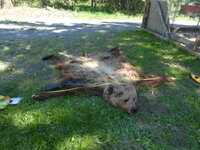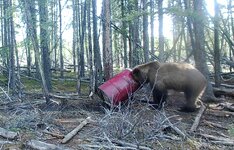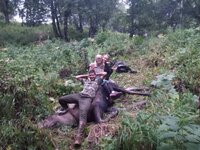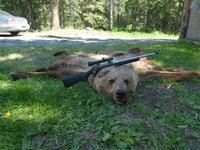There has been such a focus on bears in the .223 thread I thought I’d start a thread on what I think it takes to actually kill a bear. I am not a guide, other people have killed more bears then me. But I have killed lots of black bears, I mentored other hunters to their first bear, and I’ve killed two grizzlies solo. I’ve done this with everything from a .375 Ruger down to a .308 shooting low recoil youth loads that put it more in the category of a 6.5 Grendal.
First, I don’t care if someone brain shot a bear with a .22 rifle. That is a cool story but I don’t know anyone who wants to limit themselves to brain shots only while bear hunting. Here is what needs to happen to kill a bear reliably in a hunting situation that could turn into a self defense situation if a bear charges after being hit.
On a broadside shot a bullet needs to punch through the ribs and the lungs. If it exits that is nice but not totally necessary. Form has covered this idea in the Shoot2Hunt podcast. Its not unusual for a bullet to stop just under the skin because the skin acts like a trampoline. In other words, if your bullet stops just under the skin after going through 20 inches of one bear, it doesn’t mean the bullet will stop after going through 20 inches of a bigger bear. On a bigger bear it might go through more then 20 inches of vitals and stop under the skin.
On a quartering too shot, the bullet needs to go through a bit more muscle and maybe, a shoulder bone. Scapulas are not big deal. A brown bear’s arm bone is not huge like a bovine. If my memory is correct my 8 foot grizzly had about a 1.5 inch bone, maybe less. It was definitely less then a moose shoulder bone and probably equal to an elk, maybe less (I have never killed an elk but I have looked at elk skeletons). My only interest in breaking bones is that in some situations a bullet needs to go through a shoulder to get to the vitals. The idea of “breaking a bear down” with a shoulder hit is silly. I’ve seen bears run away very fast with a smashed shoulder.
In a head on charge situation, you want a bullet that is able to punch through a bear’s skill to hit the brain. Again, a bear’s skull is not bullet proof. If a bullet can’t make it through a bear’s skull its probably not a bullet you should be hunting with anyway. Maybe a huge grizzly has a thicker skull but the skulls I’ve seen wouldn’t stop a normal hunting bullet that could also go through a rib cage or shoulder bone of a bear or elk.
I have seen various theories on the internet about “hydrostatic shock” with the idea being if I hit an animal with a big caliber bullet or a fast enough bullet it will drop instantly. Form has quoted academic articles arguing that hydrostatic shock is a myth. I can’t speak to that but I have never seen a bear drop instantly with anything other than a brain shot. All we know for sure is that animals die when they bleed enough or their CNS is disrupted. So unless we are taking brain shots we want to make a big hole in a bear’s chest, and then get ready to shoot it again if necessary.
So to summarize, a brown bear killing bullet is nothing magical. It needs to punch through roughly the same amount of meat and bone as a bullet for elk or moose. After that, it needs to create a wide enough wound channel to quickly deprive the brain of oxygen.
Now the part we can argue about...
If I recall, it has been agreed by people like Form that a .223 does make a smaller hole than a .308 or 6.5 with an equivalent bullet. The argument in the .223 thread is that the bigger wounds of the bigger calibers don’t translate to quicker killing in deer or elk. I would argue that if a .223 can reliably kill elk it could reliably kill brown bears. But “reliably killing” might still involve animals running a bit after being hit. Not a big deal with an elk. With bears it can lead people to freak out a bit.
In summary, I think the one area where the jury is still out is whether a bear might die a bit faster if hit with a bigger bullet that creates a bigger hole draining more blood faster. In other words, maybe a .308 would be worth a bit more blast and recoil compared to a .223. I don’t know. I haven’t had the chance to try a .223 or a .308 with really destructive bullets.
First, I don’t care if someone brain shot a bear with a .22 rifle. That is a cool story but I don’t know anyone who wants to limit themselves to brain shots only while bear hunting. Here is what needs to happen to kill a bear reliably in a hunting situation that could turn into a self defense situation if a bear charges after being hit.
On a broadside shot a bullet needs to punch through the ribs and the lungs. If it exits that is nice but not totally necessary. Form has covered this idea in the Shoot2Hunt podcast. Its not unusual for a bullet to stop just under the skin because the skin acts like a trampoline. In other words, if your bullet stops just under the skin after going through 20 inches of one bear, it doesn’t mean the bullet will stop after going through 20 inches of a bigger bear. On a bigger bear it might go through more then 20 inches of vitals and stop under the skin.
On a quartering too shot, the bullet needs to go through a bit more muscle and maybe, a shoulder bone. Scapulas are not big deal. A brown bear’s arm bone is not huge like a bovine. If my memory is correct my 8 foot grizzly had about a 1.5 inch bone, maybe less. It was definitely less then a moose shoulder bone and probably equal to an elk, maybe less (I have never killed an elk but I have looked at elk skeletons). My only interest in breaking bones is that in some situations a bullet needs to go through a shoulder to get to the vitals. The idea of “breaking a bear down” with a shoulder hit is silly. I’ve seen bears run away very fast with a smashed shoulder.
In a head on charge situation, you want a bullet that is able to punch through a bear’s skill to hit the brain. Again, a bear’s skull is not bullet proof. If a bullet can’t make it through a bear’s skull its probably not a bullet you should be hunting with anyway. Maybe a huge grizzly has a thicker skull but the skulls I’ve seen wouldn’t stop a normal hunting bullet that could also go through a rib cage or shoulder bone of a bear or elk.
I have seen various theories on the internet about “hydrostatic shock” with the idea being if I hit an animal with a big caliber bullet or a fast enough bullet it will drop instantly. Form has quoted academic articles arguing that hydrostatic shock is a myth. I can’t speak to that but I have never seen a bear drop instantly with anything other than a brain shot. All we know for sure is that animals die when they bleed enough or their CNS is disrupted. So unless we are taking brain shots we want to make a big hole in a bear’s chest, and then get ready to shoot it again if necessary.
So to summarize, a brown bear killing bullet is nothing magical. It needs to punch through roughly the same amount of meat and bone as a bullet for elk or moose. After that, it needs to create a wide enough wound channel to quickly deprive the brain of oxygen.
Now the part we can argue about...
If I recall, it has been agreed by people like Form that a .223 does make a smaller hole than a .308 or 6.5 with an equivalent bullet. The argument in the .223 thread is that the bigger wounds of the bigger calibers don’t translate to quicker killing in deer or elk. I would argue that if a .223 can reliably kill elk it could reliably kill brown bears. But “reliably killing” might still involve animals running a bit after being hit. Not a big deal with an elk. With bears it can lead people to freak out a bit.
In summary, I think the one area where the jury is still out is whether a bear might die a bit faster if hit with a bigger bullet that creates a bigger hole draining more blood faster. In other words, maybe a .308 would be worth a bit more blast and recoil compared to a .223. I don’t know. I haven’t had the chance to try a .223 or a .308 with really destructive bullets.




